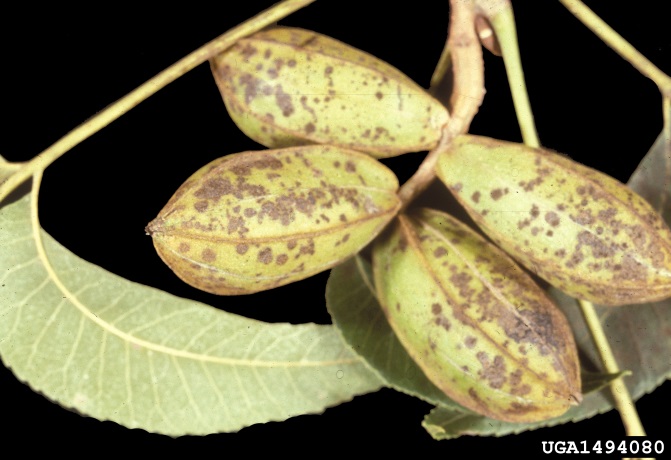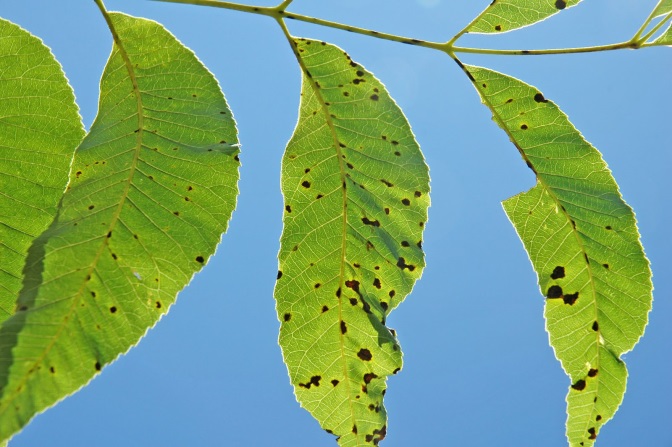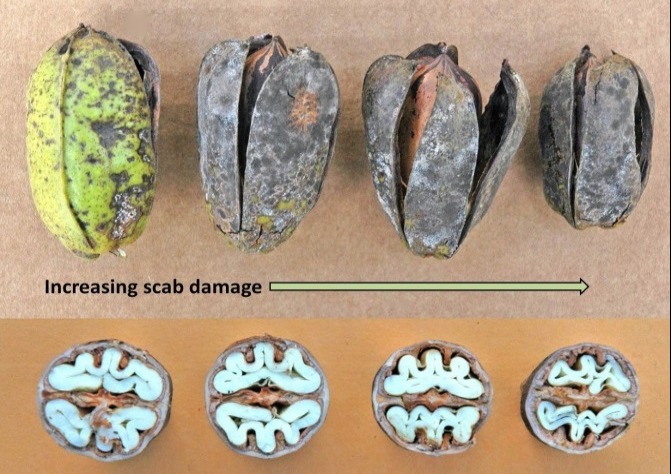
Pecan scab
| Primefact number | Edition | Published | Author |
|---|---|---|---|
| 1445 | First | Mar 2016 | Plant Biosecurity and Product Integrity |



Pecan scab (Fusicladium effusum) is an exotic plant pest not present in Australia. This disease is a serious threat to Australia’s pecan industry.
Pecan scab can infect pecan leaves, new growth, catkins and shucks and can lead to considerable yield loss.
Pecan scab is the most important disease of pecan in the United States where yield losses of up to 100% have been recorded in certain cultivars without regular fungicide application.
Notifiable status
Pecan scab (Fusicladium effusum) is a notifiable plant disease in NSW.
All notifiable plant pests and diseases must be reported within 1 working day. You can report notifiable plant pests and diseases by one of the following methods:
- Call the Exotic Plant Pest Hotline 1800 084 881
- Email biosecurity@dpi.nsw.gov.au with a clear photo and your contact details
- Complete an online form
A full list of notifiable plant pests and diseases can be found in Schedule 2 of the NSW Biosecurity Act 2015.
Description
Pecan scab symptoms are similar on all infected parts of the plants. Pecan scabs can be up to 7 mm in diameter and individual scabs can combine to form larger disease lesions.
Scabs begin as small, olive green to black, velvety spots on leaves and nut shucks.
As scabs age, they turn hard and form a dark grey or silvery to brown spot. These spots may be slightly raised.
The scabs can be seen on both surfaces of the leaves and are often associated with the veins. Older scabs will extend through the leaf, crack and drop out of the leaf, resulting in a shot-holed appearance.
Similar symptoms
Pecan scab symptoms can appear similar to anthracnose infections.
Scab appears as many individual spots, less than 7 mm in size, that combine to form larger lesions.
Anthracnose usually appears as a lesion at the end or edge of a shuck or leaf that progressively enlarges to cover the entire surface. Anthracnose lesions are shiny, dark brown and sunken with salmon coloured spores within.
Damage
Pecan scab reduces nut yield and quality both by infecting nuts directly and through the loss of foliage contributing to energy production.
Infected leaves and nuts can be dropped from the tree prematurely. Nuts that remain attached to the tree have reduced nut size and lower kernel fill, oil, moisture and protein content.
Infection of early in the season leads to deformities and cracks in the shuck, so that the nut is more susceptible to infection by other diseases.
Spread
Pecan scab is carried on infected plant material and can be spread with the movement of host plants to new locations. The disease is not known to be seed borne.
Local spread occurs when fungal spores are dispersed by rain splash and wind.
Hosts
Commercial pecan (Carya illinoinensis) is the most important host of pecan scab. All hosts are grouped within the Carya genus and include bitter pecan (C. aquatica), bitternut hickory (C. cordiformis), pignut hickory (C. glabra), shagbark hickory (C. ovata) and mockernut hickory (C. tomentosa).
Distribution
Pecan scab is believed to have originated from the USA and is presently the most common and damaging pecan disease across North, Central and South America. Pecan scab has also been reported from South Africa and New Zealand.
Actions to minimise risk
Put in place biosecurity best practice actions to prevent entry, establishment and spread of pests and diseases:
- practice “Come clean, Go clean”
- ensure all staff and visitors are instructed in and adhere to your business management hygiene requirements
- monitor your crop regularly
- source plant material of a known high health status from reputable suppliers
- keep records

